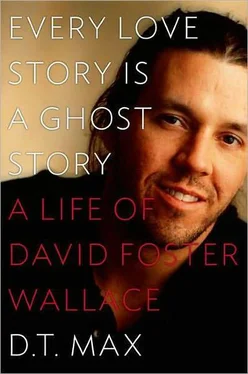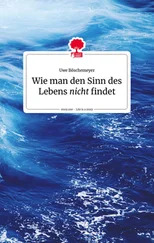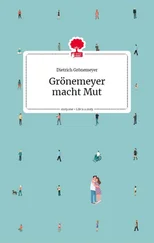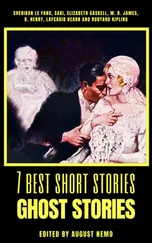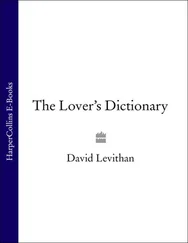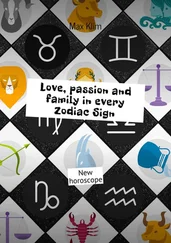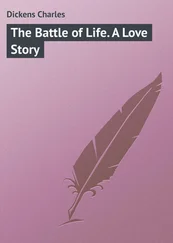32. Typically, Wallace met DeLillo through worries about plagiarism. He was concerned that DeLillo’s work was a too obvious source for the Eschaton scene in Infinite Jest , in which Ennet Academy students pretend to wage a nuclear war with computers and tennis balls. DeLillo, who admired Wallace’s writing, responded that it was not, a generous gesture given the scene’s overlap with his novel Endzone .
Chapter 6: “Unalone and Unstressed”
1. In Infinite Jest the government sells naming rights to each year. The year in which the key action in the story takes place is the “Year of the Depend Adult Undergarment,” which most Wallace researchers agree was 2009. There is, however, one bit of data that points to 2011, possibly an error, possibly a deliberately misleading clue on Wallace’s part.
2. Marathe is an example of the pleasure Wallace takes in recursion: He is a quadruple agent whose Quebecois bosses think he is a triple agent. In other words, he pretends that he is only pretending to betray the people he is in fact betraying.
3. In Infinite Jest , Wallace traces Americans’ neediness with a Freudian touch to the original mother-infant bond. The lethal “Infinite Jest” cartridge is said to consist of a baby looking up at a mother’s face, the mother intoning, “I’m sorry. I’m so terribly sorry. I am so, so sorry. Please know how very, very, very sorry I am.”
4. “Ticket to the Fair” was not the first time Wallace had improved on reality. In “Tennis, Trigonometry, Tornadoes,” for instance, he says he was born in Philo, Illinois, a claim that later found its way onto websites and into books on the author. And who but an East Coast reader would have believed that a tornado could blow up out of nowhere and suddenly sweep Wallace and his tennis opponent over the net, “blown pinwheeling for I swear it must have been fifty feet over to the fence one court over”? As Amy Wallace remembers, in the Wallace family, ”We quietly agreed that his nonfiction was fanciful and his fiction was what you had to look out for.”
5. Wallace was aware that he had transgressed, and many times he hinted to journalists that their rules weren’t his, as in an interview he gave to a writer for the Boston Phoenix in 1998: “The thing is, really — between you and me and the Boston Phoenix’s understanding readers — you hire a fiction writer to do nonfiction, there’s going to be the occasional bit of embellishment.”
6. The problem of how to use an innovative writing style to carry out a conservative fictional purpose would become Wallace’s biggest artistic challenge and would prove insurmountable in The Pale King .
7. One suspects the silver lamé outfit was borrowed from Wurtzel and the vomit, as at the Illinois State Fair, was invented, both being, in magazine fact-checking parlance, on author. A description of losing to a nine-year-old girl at chess in the ship’s library that only appears in the book version of the piece also has the sort of headlong specificity that characterized Wallace’s enhancements for effect, viz: “My first inkling of trouble is on the fourth move, when I fianchetto and Deirdre knows what I am doing is fianchettoing and uses the term correctly…. My second ominous clue is the way her little hand keeps flailing out to the side of the board after she moves, a sign that she is used to a speed clock. She swoops in with her developed QK and forks my queen on the twelfth move.”
8. The news reports Wallace refers to were probably about Grant Medeiros, fourteen, of Saanich, British Columbia. On February 17, 1995, on the last night of a cruise aboard the Royal Princess , Medeiros vanished. His eyeglasses and shoes were found on the deck, and he left his necklace and a note in his parents’ cabin, but no one saw him jump, and his body was never found. The press ascribed his misery to fighting with his parents over having to join them on the cruise. The part about a “a ship-board romance” was likely Wallace’s invention.
9. On the junior circuit, Wallace and his friends had run into a player with the name of the movie star; this spurred them to make lists of ordinary people with famous names.
10. When Big Craig read the novel after it was published he remembers thinking, “Holy crap! The bastard was just looking for information.” For all that Wallace subscribed to the ethos of anonymity in recovery, his fiction always came first. “You didn’t get sober to fuck people over [but] it’s a hazard in writing,” he wrote a friend.
11. Another source for the name may have been the nickname he and Costello shared for junior lawyers, “compliance drones.”
12. He wrote in a notebook a few years later, “My dog-emotions shifted when Drone came — there was sort of one to break my heart w/ goodness and one who was ‘trouble.’”
13. Blue is a dominant color in Infinite Jest . One character is killed drinking Drano, “blue like glittershit”; another reveals “a blue string” behind an eyeball; Joelle vomits “blue smoke” into “the cool blue tub” when she hits bottom; the Charles is transformed to “robin-egg’s blue” by the Clean US Party; the skies of the novel range from “Dilaudid-colored” to “pilot-light blue”; one section begins simply, “The following things in the room were blue.”
14. Wallace was becoming a brand of his own. “I think he will fulfill Nick’s request for a big-name writer,” an editor at Tennis wrote a colleague after approaching Wallace to write a piece on the U.S. Open for the magazine.
15. The point of his style he omitted. Perhaps he thought it was self-evident, but in a similar fax to Harper’s before the editing of a piece he published in 1998 on Kafka, he explained that his goal was to “preserve an oralish, out-loud feel” to his writing. That piece began as a talk, but it is also true of Infinite Jest . You are meant to think of it as a story being spoken rather than written — or even better, thought.
16. As Amy Wallace remembers, when mother and son discussed Infinite Jest that winter, Wallace insisted to his mother that Avril Incandenza was not based on her. She was not persuaded, and the parts of the book about Avril left her deeply upset.
17. Rock music was the cultural venue in which signs of disaffection and dis-ease first appeared with serious energy. In the early 1990s bands like Pearl Jam and Nirvana sang of alienation and sophisticated frustration. Their music emphasized the personal rather than the political, much as Wallace’s fiction did.
18. At a panel discussion on ethnicity and literature in 1998 held in Seattle, Wallace indicated that he understood his privileged status. When the moderator announced that the authors — the others were Sherman Alexie, Cristina García, and Gish Jen — would discuss their experience as members of marginalized minorities, Wallace picked up his chair and with comic exaggeration moved it to the side of the stage.
19. Younger readers had an easier time with Infinite Jest ’s structure. It was in fact an undergraduate who captured Wallace’s strategy best. In the fall of 1995, Christopher Hager, who was studying literature with Gilbert Sorrentino at Stanford University, wrote to the author to discuss Girl with Curious Hair . Wallace offered him a galley of his next work instead if Hager would get his friends to buy the book when it came out, joking that if they bought ten copies among them, it would increase Little, Brown’s net sales “by at least 25 %.” In “On Speculation: Infinite Jest and American Fiction after Postmodernism,” his undergraduate thesis, Hager captured the novel’s “incomplete” ending with delicacy:
Читать дальше
